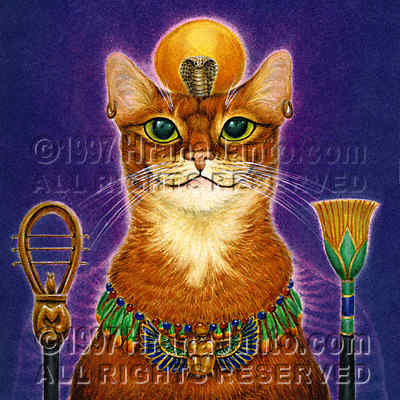 |
|
|||||
PREVIOUS | NEXT | A,B,C, D,E, F,G,H,I, J,K,L,M, N,O,P,Q, R,S, T,U,V,W,X,Y,Z | Help | ALL | INDEX
| Bast from Goddesses and Heroines |
Exerpt from Goddess & Heroines by Patricia
Monaghan [Used by permission. This text is NOT included in the Goddess Oracle] |
She originated in the Nile delta, but by 930 B.C., the power of Bast was acknowledged by all Egyptians, even those a thousand miles south of her original home. At first she was a lion-goddess of sunset, symbolizing the fertilizing force of the sun's rays. Later her image grew tamer: she became a cat carrying the sun, or a cat-headed woman who bore on her breast plate the lion of her former self.
Bast ruled pleasure and dancing, music and joy. At the city of Bubastis ("house of Bast"), the center of her worship, great celebrations were held. Boatloads of worshipers--hundreds of thousands of them, Herodotus said--were greeted by pleasant flute melodies as they debarked for a worship service combined with a vast trade fair. Bast's followers believed that in return for this reverent celebration Bast bestowed both mental and physical health. As part of Bast's worship, Egyptians honored live cats. Domesticated (if cats can ever be truly said to be domesticated) during the early period of agriculture, cats were useful to keep down the rodent population and therefore to assure a stable diet for humans. Egyptians cherished their cats, often decking them with golden earrings or other jewelry. When they died, the cats were mummified and buried in the vast cat cemetary at Bubastis.
| Back to TOP | Published by Llewellyn, copyright 1997. Used by permission of the author. |
![]()